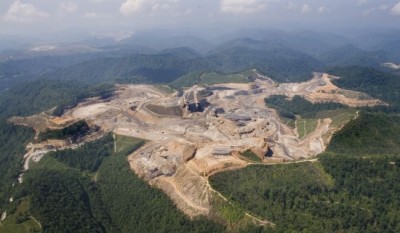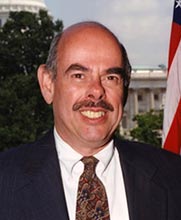As Grist readers know, the House Energy Committee has been behind closed doors hashing out a compromise version of the Waxman-Markey climate and energy bill. Some details of the compromise were announced earlier this week. Today saw the release of the proposal for allocating pollution permits under the compromise bill (reprinted in full at the bottom of this post).
(The full bill is now available as well, but I’ll focus on pollution permits here.)
Some enviros are reacting in horror, calling for full opposition (and, of course, proposing pony alternatives). [UPDATE: Greenpeace, Friends of the Earth, and Public Citizen are “extremely troubled.”] [UPDATE2: I more or less endorse UCS’s analysis.]
Maybe I’m cynical but this is better than I expected. A couple of things to keep in mind:
The House Energy Committee is packed with legislators from coal, oil, steel, and manufacturing states. Check out this illuminating data, from a new paper [PDF] to be published by UCLA economics professor Matthew Kahn:
The average Democrat on [the Energy and Environment Subcommittee of the House Energy and Commerce Committee] represents a district whose per-capita carbon emissions are 31 percent higher than the average Democrat in Congress, and the average Republican on this subcommittee represents a district whose emissions are 20 percent higher than the average Democrat on this committee. These numbers tell a clear story that the Energy and Environment Subcommittee consists of members of both parties who represent carbon-intensive districts.
This means, ironically, that the House Energy Subcommittee is extremely hostile territory for low-carbon legislation. On the flip side, a bill that can get out of this committee has a good chance of satisfying the demands of the wider Congress. This proposal probably represents the floor — there’s a chance it could be strengthened by the Senate Environment and Public Works committee, and later conference committee. I don’t think it will get much worse. (Yes, some day I could eat those words.)
Secondly, it’s not great that a third of the permits are being allocated for free to utilities, but insofar as that was a necessary compromise to get Rep. Rick Boucher (D-Va.) et al. on board, this is about the best way to do it. Most of the permits for utilities go to local electric distribution companies (LDCs), which are tightly regulated; regulators can force them to use the value to shield consumers instead of pocketing windfall profits. (That’s if watchdogs do their job.)
Thirdly, while most of the free allocations phase out over the next 5 to 10 years, the allocations (15%) devoted to helping low-income ratepayers do not. [UPDATE: Well, this last sentence is wildly wrong, as you will note if you actually read the document below. (D’oh!) The free allowances phase out over 5-10 years, but not the next 5-10 years. In fact, they don’t start phasing out until 2026, which … sucks. More on this in a subsequent post.]
Fourthly, note that around 20% of permits are going toward investing in renewable energy and efficiency, roughly in line with Obama’s budget proposal.
It’s galling, yes, that “clean coal” and oil refineries each get more (2%) than R&D, as much as deforestation, as much as international assistance, and that “clean coal” permits go up, not down, in 2018, and that fully 15% of permits are set aside for dirty industry. But deals had to be made, and the need for deals wouldn’t have vanished with alternative pony policies like cap-and-dividend.
More on the full bill later. Permit allocation document below.
—–
Proposed Allowance Allocation
Chairman Henry A. Waxman and Chairman Edward J. Markey
May 14, 2009
Emission allowances will be allocated to accomplish three primary goals: (1) to protect consumers from energy price increases; (2) to assist industry in the transition to a clean energy economy; and (3) to spur energy efficiency and the development and deployment of clean energy technology. A small amount of allowances will be allocated to prevent deforestation and support national and international adaptation efforts and for other purposes.
Consumer Protection
Protection from Electricity Price Increases: The electricity sector will receive 35% of the allowances, representing 90% of current utility emissions. Local electric distribution companies, whose rates are regulated by the states, will receive 30% of the allowances, which they must use to protect consumers from electricity price increases. Merchant coal and long-term power purchase agreements will receive 5% of the allowances. These allowances will be distributed according to a formula recommended by the utility industry and will phase out over a five-year period from 2026 through 2030.
Protection from Natural Gas Price Increases: Local natural gas distribution companies, whose rates are regulated by the states, will receive 9% of allowances, which they must use to protect consumers from natural gas price increases. These allowances will phase out over a five-year period from 2026 through 2030.
Protection from Home Heating Oil Price Increases: States will receive 1.5% of allowances for programs to benefit users of home heating oil and propane. These allowances will phase out over a five-year period from 2026 through 2030.
Protection of Low- and Moderate-Income Households: 15% of allowances will be auctioned each year and the proceeds of these allowances will be distributed to low- and moderate-income families to protect them from other energy cost increases. These allowances will be distributed through tax credits, direct payments, and electronic benefit payments and will not phase out.
Transition Assistance for Industry
Protection for Energy-Intensive, Trade-Exposed Industries: Pursuant to the Inslee-Doyle program, energy-intensive, trade-exposed industries will receive allowances to cover their increased costs from the global warming protection program. The number of allowances set aside for this program will equal 15% of the allowances in 2014 and then decrease based on the percent reductions in the emissions targets. These allowances will phase out after 2025 unless the President decides the program is still needed.
Protection for Domestic Energy Production: Oil refiners will receive 2% of allowances starting in 2014 and ending in 2026.
Energy Efficiency and Clean Energy Technology
Investments in Carbon Capture and Sequestration: 2% of allowances from 2014 through 2017 and 5% of allowances in 2018 and subsequent years will be allocated to help electric utilities cover the costs of installing and operating carbon capture and sequestration technologies.
Investments in Renewable Energy and Energy Efficiency: States will receive 10% of allowances from 2012 through 2015; 7.5% of allowances in 2016 and 2017; 6.5% of allowances from 2018 through 2021; and 5% of allowances thereafter for investments in renewable energy and energy efficiency. (The 5% of allowances from 2022 through 2025 will include some future year allowances.)
Investments in Advanced Automobile Technology: 3% of allowances through 2017 and 1% from 2018 through 2025 will be allocated for investments in electric vehicles and other advanced automobile technology and deployment.
Investments in Research and Development: 1% of allowances will be allocated to “Clean Energy Innovation Centers” at research universities and institutions for applied research and development on clean energy technologies.
Other Public Purposes
Supplemental Reductions from Preventing Tropical Deforestation: 5% of allowances will be allocated from 2012 through 2025 to prevent tropical deforestation and build capacity to generate international deforestation offsets. By 2020, this program will achieve additional emission reductions equivalent to 10% of U.S. emissions in 2005. From 2026 through 2030, 3% of allowances will be allocated to this program. In 2031 and thereafter, 2% will be allocated to this program.
Domestic Adaptation: From 2012 through 2021, 2% of allowances will be allocated for domestic adaptation purposes. The amount of allowances allocated for domestic adaptation will increase to 4% from 2022 through 2026 and to 8% in 2027 and thereafter. Half of these allowances will be used for wildlife and natural resource protection and half for other domestic adaptation purposes, including public health.
International Adaptation and Clean Technology Transfer: From 2012 through 2021, 2% of allowances will be allocated for international adaptation and clean technology transfer. The amount of allowances allocated for these purposes will increase to 4% from 2022 through 2026 and to 8% in 2027 and thereafter. Half of these allowances will be used for adaptation and half for clean technology transfer.
Worker Assistance and Job Training: 0.5% of allowances will be allocated for worker assistance and job training from 2012 through 2021. This amount will increase to 1% thereafter. 2 3
Unallocated Allowances
Some of the unallocated allowances will be auctioned to ensure budget neutrality. The remainder will be used for consumer protection.



